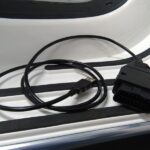Maintaining your vehicle’s memory when disconnecting the battery is crucial for a smooth operation post-reconnection. Like many modern cars, the 2013 Subaru Forester relies on constant power to retain crucial data for its control modules, radio presets, and clock. Disconnecting the battery can lead to a loss of this learned information, potentially causing temporary rough idling or reset settings. Knowing the location of your OBD2 port is essential, not just for diagnostics but also for potentially maintaining power during battery changes. This guide will pinpoint the OBD2 location in your 2013 Subaru Forester and discuss its utility in such situations.
Understanding the Importance of the OBD2 Port
The On-Board Diagnostics II (OBD2) port is a standardized interface in modern vehicles. Primarily, it serves as an access point for retrieving diagnostic trouble codes (DTCs) when your check engine light illuminates. Mechanics and car owners alike use OBD2 scanners to understand and address issues flagged by the vehicle’s computer system. Beyond diagnostics, the OBD2 port, specifically pin 16, is designed to be always powered. This constant power supply is intended for diagnostic equipment, but it can also be utilized in other scenarios, such as maintaining vehicle memory during battery disconnection.
Locating the OBD2 Port in Your 2013 Subaru Forester
For the 2013 Subaru Forester, the OBD2 port is typically located within the driver’s side footwell area. You’ll usually find it beneath the dashboard, often near the steering column. Look for a 16-pin, trapezoid-shaped connector. It’s generally easily accessible without tools and is designed for straightforward access. Pin 16 of this connector is the crucial point, as it is directly connected to the car’s battery and provides a constant 12V power supply, even when the ignition is off. This consistent power is what makes it a potential point for maintaining vehicle memory.
Using the OBD2 Port for Memory Retention During Battery Change (With Caution)
While Subaru accessory power outlets are not constantly powered, unlike some other vehicles, the OBD2 port offers an alternative for maintaining power. Pin 16’s constant power supply means you can, with the correct equipment, connect a 12V power source through the OBD2 port to keep the car’s systems powered while the main battery is disconnected. Specialized tools and adapters are available that connect a 12V source, like a jump starter, to the OBD2 port, often incorporating a 7.5 Amp fuse for safety.
However, caution is paramount. The 7.5 Amp fuse is a safety measure. It is designed to protect the system from overload. It’s critical to ensure that absolutely no accessories or lights are activated within the vehicle during this process. Even opening a door and activating interior lights could draw enough current to exceed the 7.5 Amp limit and blow the fuse. If this fuse blows, you will lose the memory you were trying to preserve, effectively negating the process and potentially causing the same issues as if you had simply disconnected the battery without any power maintenance.
In conclusion, the OBD2 port in your 2013 Subaru Forester is located in the driver’s side footwell, under the dashboard. Its pin 16 offers a constant power source that can be cautiously used to maintain vehicle memory during battery changes. Always exercise extreme caution to avoid overloading the circuit and blowing the fuse, ensuring all vehicle accessories remain off throughout the process. Understanding this location and its potential utility can be valuable for both diagnostics and basic car maintenance.
